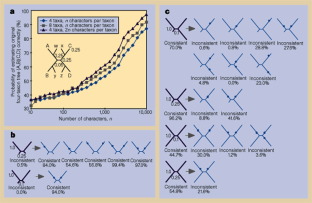Taxon sampling revisited (original) (raw)
- Scientific Correspondence
- Published: 25 March 1999
Nature volume 398, pages 299–300 (1999)Cite this article
- 407 Accesses
- 179 Citations
- Metrics details
Abstract
Phylogenies that include long, unbranched lineages can be difficult to reconstruct. This is because long-branch taxa (such as rapidly evolving species) may share character states by chance more often than more closely related taxa share derived character states through common ancestry1. Despite Kim's warning that added taxa can decrease accuracy2, some authors have argued that the negative impact of this error, called ‘long-branch attraction’, is minimized when slowly evolving lineages are included to subdivide long branches3,4,5. From this they have concluded that increasing the number of species sampled per lineage results in better accuracy than increasing the number of characters per species6. We find, using computer simulations, that adding characters can be the more favourable strategy, even for long-branched trees, and that adding slowly evolving taxa to subdivide long branches can reduce accuracy.
This is a preview of subscription content, access via your institution
Access options
Subscribe to this journal
Receive 51 print issues and online access
$199.00 per year
only $3.90 per issue
Buy this article
- Purchase on SpringerLink
- Instant access to full article PDF
Prices may be subject to local taxes which are calculated during checkout
Additional access options:
Figure 1: Modelling of phylogenetic strategies.

References
- Felsenstein, J. Syst. Zool. 27, 401–410 (1978).
Google Scholar - Kim, J. Syst. Biol. 45, 363–374 (1996).
Google Scholar - Hendy, M. & Penny, D. Syst. Zool. 38, 297–309 (1989).
Google Scholar - Hillis, D. M. Nature 383, 130 (1996).
Article Google Scholar - Swofford, D. L., Olsen, G. J., Waddel, P. J. & Hillis, D. M. in Molecular Systematics 2nd edn (eds Hillis, D. M., Moritz, C. & Mable, B. K.) 407-514 (Sinauer, 1996).
- Graybeal, A. Syst. Biol. 47, 9–17 (1998).
Google Scholar - Waddel, P. Statistical Methods of Phylogenetic Analysis. Thesis, Massey Univ. (1995).
- Yang, Z. J. Mol. Evol. 42, 294–307 (1996).
Google Scholar - Cavender, J. A. & Felsenstein, J. J. Class. 4, 57–71 (1987).
Google Scholar - Swofford, D. L. PAUP developmental versions (Sinauer, 1998).
Author information
Authors and Affiliations
- Division of Amphibians and Reptiles, MRC 162, National Museum of Natural History, Smithsonian Institution, Washington, DC 20560, USA
Steven Poe - Department of Zoology and Texas Memorial Museum, University of Texas, Austin, 78712, Texas, USA
Steven Poe - Laboratory of Molecular Systematics, Smithsonian Institution, Washington, 20560, DC, USA
David L. Swofford
Authors
- Steven Poe
- David L. Swofford
Rights and permissions
About this article
Cite this article
Poe, S., Swofford, D. Taxon sampling revisited.Nature 398, 299–300 (1999). https://doi.org/10.1038/18592
- Issue Date: 25 March 1999
- DOI: https://doi.org/10.1038/18592